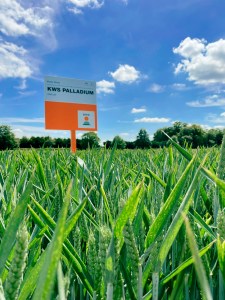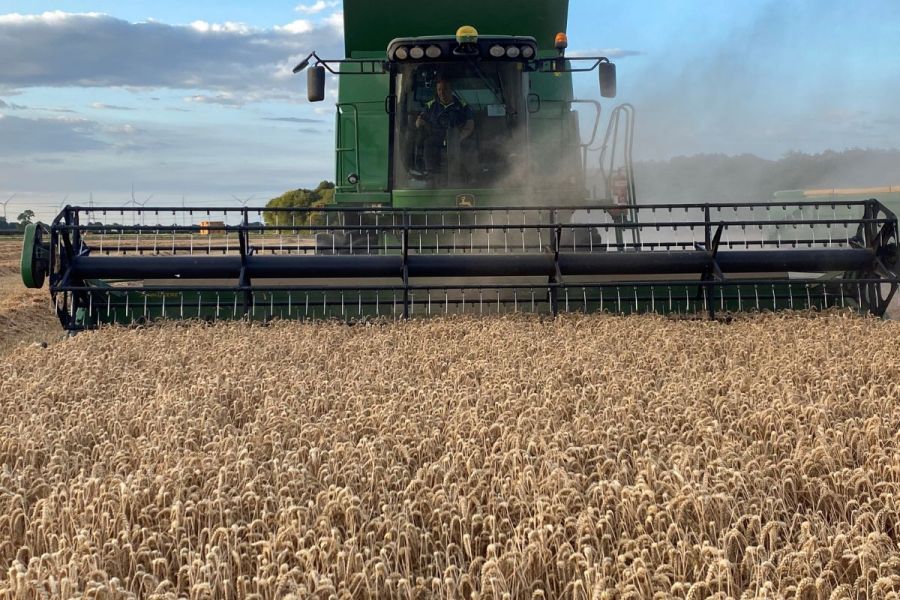While high yielding wheats might not be the obvious choice when it comes to building a resilient rotation, harnessing the power of genetics could help growers reduce both their operational and environmental costs. CPM finds out more.
“We’ve got to be more responsible with variety choice.”
By Charlotte Cunningham
Yield has long been king when it comes to variety selection, but aside from just providing large volumes of grain in the shed, careful consideration when looking at this trait could be key for achieving long-term sustainable production.

Looking at overall yield potential is a good starting point when selecting varieties to try and build sustainability into the rotation, says Kirsty Richards.
And while high yielding wheats and sustainability might not go obviously hand-in-hand, KWS’s Kirsty Richards says that high yield potential is actually a proven indicator of how well a plant is able to use available nutrients, with the highest yielding varieties on the AHDB Recommended List being arguably the ones with the highest levels of nitrogen use efficiency.
“From a grower’s perspective, this means looking at overall yield potential as a starting point when selecting varieties to try and build sustainability into the rotation,” she says.
But high untreated yield is becoming increasingly important too, particularly for growers who are actively pursuing a more sustainable approach, adds Kirsty. “Untreated yield scores tell us more than just grain output and are often indicators of many factors such as plant strength and resilience as well as disease resistance. This gives growers the opportunity to not only grow more resilient varieties, but also to reduce inputs and labour – all of which are key components in building overall business sustainability.”
From an economic perspective, senior agribusiness analyst James Webster of The Anderson Centre says varieties that excel in this department will be the backbone of future rotations amid a backdrop of continually rising energy costs and an industry drive to reduce inputs.
“It’s a bit of a split picture in terms of cost at the moment,” says James. “Some costs have come down – most noticeably fertiliser – but others that are more inflation linked, such as agrichemicals and fixed costs, remain high.
“If we look ahead to the 2024 harvest, while we’re better off than 2023, the cost of production is and will remain high so it’s really important to think about the sustainability of your rotations both from a financial context and also environmentally.”

From an economic perspective, resilient high performing varieties will be the backbone of future rotations amid a backdrop of continually rising energy costs and an industry drive to reduce inputs, believes James Webster.
Variety-wise, James echoes Kirsty’s sentiments and says that varieties with good untreated yields – combined with other functional traits like high disease resistance – do indeed indicate an overall more resilient type and will help provide businesses with a solid foundation.
“Varieties that are stronger on these traits allow growers to take a more integrated approach to the whole management of crop production, which may include being more flexible with costly inputs – or even reducing them. Taking advantage of inherent strengths of a variety to help limit cost bases is going to be hugely important going forward.”
But it’s not all about economic cost – resilient, high yielding varieties can be beneficial from an environmental perspective too, he adds. “We know that pesticide usage is something that policy is targeting and reducing insecticides is coming through via the Sustainable Farming Incentive. So once again, if you can work with the varieties, we can start moving in the right direction to be able to reduce some of these inputs.
“Ammonia and nitrous oxide emissions are also another key part of the target framework being produced by the Government’s Environmental Improvement Plan. Selecting for this via varietal scores enables growers to ensure they’re still able to achieve a good yield but achieving it in a more sustainable way.”
From a practical perspective, these high yielding untreated types can also help bring an element of flexibility to farm management, adds James. “This could include spreading workload at times when labour availability is tight. Also, if the conditions aren’t quite right, having genetics on your side through good untreated yields may allow you to be more flexible with application timings.

Olivia Potter says that Group 4 hard wheat KWS Dawsum is a good example of how high yield and fully featured agronomics can work together.
“Varieties where we see all of these features working together gives them real versatility and flexibility.”
KWS technical specialist Olivia Potter picks up the conversation and concurs that Group 4 hard wheat KWS Dawsum is a good example of how high yield and fully featured agronomics can work together. “KWS Dawsum is a great benchmark for an all-round wheat that can work equally well in conventional production as well as in more regenerative systems.
“For a start, it’s got high outright yield at 104% of control, indicating it uses available nitrogen very efficiently. But it also has a high untreated yield at 95%, just 2% behind the highest performer in this respect – KWS Extase at 97%. This is underpinned by resistance scores of 9 for yellow rust, an 8 for mildew, 7 for brown rust and 6.4 for septoria.
“Robust genetics also ensures KWS Dawsum delivers to its full potential across the rotation, regardless of heavy or light soil, early or later drilling, and whether it’s in a first or second wheat slot, with short, stiff straw further adding to its overall resilience.”
Looking at other resilient options currently on the market, there are four wheats in the KWS stable, including KWS Dawsum, which achieved scores of more than 90% for untreated yield, according to the 2023/24 RL.

KWS Palladium’s septoria resistance has a different genetic basis from all other commercialised Group 2 varieties, which is positive from a sustainability perspective.
KWS Extase sits top of the table with an untreated yield of 97% of control – the highest on the RL. “Extase is a Group 2 milling type which combines untreated yield with high disease resistance and the ability to be grown across a wide range of soil types and locations,” says Olivia.
“Most significantly, Extase has an exceptional resistance to septoria with a score of 7.8. In practical terms this could allow growers to start thinking about reducing costly inputs, while still achieving good disease control, and most importantly, yield.”
Also combining high untreated yield and excellent disease resistance is KWS Palladium – a Group 2 bread-making type which boasts an overall yield score of 100%, an untreated yield of 94% and a septoria score of 7.4.
“What’s particularly good about Palladium from a sustainability perspective is that its septoria resistance has a different genetic basis from all other commercialised Group 2 varieties,” adds Olivia.
New for this year, KWS Ultimatum is another high yielding Group 2 option, she says. “Ultimatum is particularly at home in the north, with the highest yield score of 103% in the Group 2 sector, giving it yield potential similar to what’s often only achieved in high yielding feed types.”
Looking to its untreated credentials, Ultimatum gleans a score of 93% and combines this with good disease resistance – particularly to fusarium (7) – and UKP approval, giving growers access to additional market opportunities, she concludes.
This article was taken from the latest issue of CPM. Read the article in full here.
For more articles like this, subscribe here.
Sign up for Crop Production Magazine’s FREE e-newsletter here.




